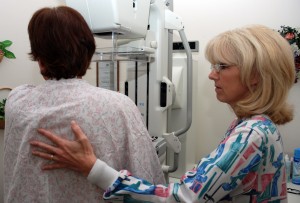But women with dense breasts are also at higher risk of false positives and may need to go through additional imaging and unnecessary biopsies. How much? The researchers report that women with extremely dense breasts have a 65.5 percent likelihood of a false positive over a ten year period. Still, "annual screening has added benefit to detect breast cancer at an earlier stage" than screening every other year, the researchers write.
(As an aside: if you're a woman in your 40s with doctor-diagnosed "extremely dense breasts," then your risk of breast cancer matches that of an average-risk woman in her 50s, according to the analysis.)
In the study, published in this week's JAMA Internal Medicine, researchers looked at nearly one million women -- more than 11,000 women with breast cancer and more than 900,000 without breast cancer, all of whom had mammograms.
Researchers also looked at women who used hormone therapy after menopause. Hormone therapy has been shown to increase a woman's risk of breast cancer. For women ages 50-74, even for women with dense breasts or hormone therapy use, annual screening made no difference.
"They could be screened every two years and have the same benefit as being screened every year and fewer harms from mammography," Kerlikowske said.
Those harms can be common. If you're a woman in the 50-74 group, with less dense breasts (a "2" scored by a radiologist), and do not take hormone therapy, your risk of a false positive after ten years of annual mammography is 49.8 percent. The likelihood of a false positive falls to 30.7 percent if a woman is having a mammogram every other year.
In a separate study this week, researchers found that these false positives lead to "long-term psychosocial harm" for many women.
It's unlikely that recommendations will be changed based on this study. The American Cancer Society offers different recommendations than the U.S. Preventive Services Task Force. The ACS continues to recommend an annual mammogram for women beginning at age 40. The group's chief medical officer, Dr. Otis Brawley says he doesn't "see us changing right now."
But he also said he could foresee a time of targeted recommendations for women-- not just for having mammograms more frequently, but less frequently, too.
"I think we are moving toward a period of time," Brawley said, "where we will identify through a bunch of questions that involve family history, age, density of breast tissue ... whether one is menopausal or not menopausal, and we're going to have a group of women who will be in their 50s, and we will tell them you ought to have a mammogram every three years."
He added there could be a group that needs mammograms annually and a very targeted group that might need to be screened even more frequently.
New law takes effect April 1st
The study comes just as a new law is scheduled to take effect in California. Starting April 1st, radiologists will be required to notify women if they have heterogeneously dense or extremely dense breast tissue (category 3 or 4). Radiologists already send women a report after their mammogram; they would add this information to that letter.
The law passed with overwhelming support in the California legislature, but Brawley says aside from extremely dense breasts, that breast density is a subjective measure. UCSF's Kerlikowske says she thinks the "law is ahead of the science," because there's no data showing that other kinds of screening tests, such as ultrasound or MRI, have any benefit for these women.
